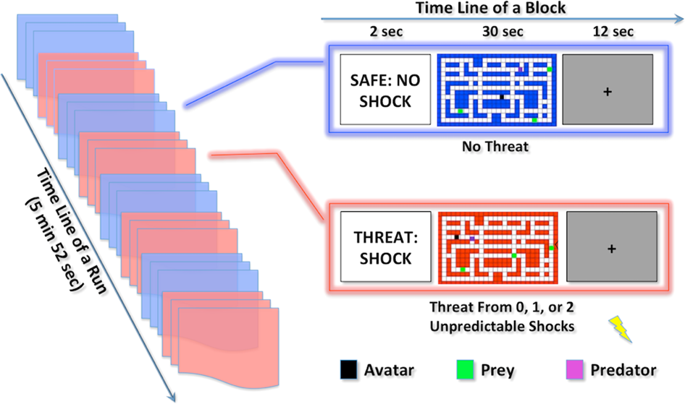当前位置:
X-MOL 学术
›
Transl. Psychiaty
›
论文详情
Our official English website, www.x-mol.net, welcomes your
feedback! (Note: you will need to create a separate account there.)
Threat-induced anxiety during goal pursuit disrupts amygdala-prefrontal cortex connectivity in posttraumatic stress disorder.
Translational Psychiatry ( IF 5.8 ) Pub Date : 2020-02-10 , DOI: 10.1038/s41398-020-0739-4 Delin Sun 1, 2 , Andrea L Gold 3, 4 , Chelsea A Swanson 1, 2 , Courtney C Haswell 1, 2 , Vanessa M Brown 5 , Daniel Stjepanovic 1, 2 , , Kevin S LaBar 1, 2 , Rajendra A Morey 1, 2
Translational Psychiatry ( IF 5.8 ) Pub Date : 2020-02-10 , DOI: 10.1038/s41398-020-0739-4 Delin Sun 1, 2 , Andrea L Gold 3, 4 , Chelsea A Swanson 1, 2 , Courtney C Haswell 1, 2 , Vanessa M Brown 5 , Daniel Stjepanovic 1, 2 , , Kevin S LaBar 1, 2 , Rajendra A Morey 1, 2
Affiliation

|
To investigate how unpredictable threat during goal pursuit impacts fronto-limbic activity and functional connectivity in posttraumatic stress disorder (PTSD), we compared military veterans with PTSD (n = 25) vs. trauma-exposed control (n = 25). Participants underwent functional magnetic resonance imaging (fMRI) while engaged in a computerized chase-and-capture game task that involved optimizing monetary rewards obtained from capturing virtual prey while simultaneously avoiding capture by virtual predators. The game was played under two alternating contexts-one involving exposure to unpredictable task-irrelevant threat from randomly occurring electrical shocks, and a nonthreat control condition. Activation in and functional connectivity between the amygdala and ventromedial prefrontal cortex (vmPFC) was tested across threat and nonthreat task contexts with generalized psychophysiological interaction (gPPI) analyses. PTSD patients reported higher anxiety than controls across contexts. Better task performance represented by successfully avoiding capture by predators under threat compared with nonthreat contexts was associated with stronger left amygdala-vmPFC functional connectivity in controls and greater vmPFC activation in PTSD patients. PTSD symptom severity was negatively correlated with vmPFC activation in trauma-exposed controls and with right amygdala-vmPFC functional connectivity across all participants in the threat relative to nonthreat contexts. The findings showed that veterans with PTSD have disrupted amygdala-vmPFC functional connectivity and greater localized vmPFC processing under threat modulation of goal-directed behavior, specifically related to successfully avoiding loss of monetary rewards. In contrast, trauma survivors without PTSD relied on stronger threat-modulated left amygdala-vmPFC functional connectivity during goal-directed behavior, which may represent a resilience-related functional adaptation.
中文翻译:

目标追求期间的威胁引起的焦虑会破坏创伤后应激障碍中的杏仁核-前额叶皮质连接。
为了研究目标追求过程中不可预测的威胁如何影响创伤后应激障碍 (PTSD) 中的额叶边缘活动和功能连接,我们比较了患有 PTSD 的退伍军人 (n = 25) 与创伤暴露对照 (n = 25)。参与者在进行计算机化的追逐和捕获游戏任务时接受了功能性磁共振成像 (fMRI),该任务涉及优化从捕获虚拟猎物获得的金钱奖励,同时避免被虚拟捕食者捕获。游戏是在两种交替的环境下进行的——一种涉及暴露于不可预测的任务无关的威胁,来自随机发生的电击,另一种是非威胁控制条件。杏仁核和腹内侧前额叶皮层 (vmPFC) 的激活和功能连接在威胁和非威胁任务环境中通过广义心理生理相互作用 (gPPI) 分析进行了测试。PTSD 患者报告的焦虑程度高于对照组。与非威胁环境相比,通过成功避免受到威胁的捕食者捕获所代表的更好的任务表现与对照组中更强的左侧杏仁核-vmPFC 功能连接和 PTSD 患者中更大的 vmPFC 激活相关。PTSD 症状严重程度与暴露于创伤的对照组中的 vmPFC 激活呈负相关,并且与相对于非威胁环境的威胁中所有参与者的右侧杏仁核-vmPFC 功能连接呈负相关。研究结果表明,患有 PTSD 的退伍军人在目标导向行为的威胁调制下破坏了杏仁核-vmPFC 功能连接和更大的本地化 vmPFC 处理,特别是与成功避免金钱奖励损失有关。相比之下,没有 PTSD 的创伤幸存者在目标导向行为期间依赖于更强的威胁调节的左侧杏仁核-vmPFC 功能连接,这可能代表了与复原力相关的功能适应。
更新日期:2020-02-10
中文翻译:

目标追求期间的威胁引起的焦虑会破坏创伤后应激障碍中的杏仁核-前额叶皮质连接。
为了研究目标追求过程中不可预测的威胁如何影响创伤后应激障碍 (PTSD) 中的额叶边缘活动和功能连接,我们比较了患有 PTSD 的退伍军人 (n = 25) 与创伤暴露对照 (n = 25)。参与者在进行计算机化的追逐和捕获游戏任务时接受了功能性磁共振成像 (fMRI),该任务涉及优化从捕获虚拟猎物获得的金钱奖励,同时避免被虚拟捕食者捕获。游戏是在两种交替的环境下进行的——一种涉及暴露于不可预测的任务无关的威胁,来自随机发生的电击,另一种是非威胁控制条件。杏仁核和腹内侧前额叶皮层 (vmPFC) 的激活和功能连接在威胁和非威胁任务环境中通过广义心理生理相互作用 (gPPI) 分析进行了测试。PTSD 患者报告的焦虑程度高于对照组。与非威胁环境相比,通过成功避免受到威胁的捕食者捕获所代表的更好的任务表现与对照组中更强的左侧杏仁核-vmPFC 功能连接和 PTSD 患者中更大的 vmPFC 激活相关。PTSD 症状严重程度与暴露于创伤的对照组中的 vmPFC 激活呈负相关,并且与相对于非威胁环境的威胁中所有参与者的右侧杏仁核-vmPFC 功能连接呈负相关。研究结果表明,患有 PTSD 的退伍军人在目标导向行为的威胁调制下破坏了杏仁核-vmPFC 功能连接和更大的本地化 vmPFC 处理,特别是与成功避免金钱奖励损失有关。相比之下,没有 PTSD 的创伤幸存者在目标导向行为期间依赖于更强的威胁调节的左侧杏仁核-vmPFC 功能连接,这可能代表了与复原力相关的功能适应。











































 京公网安备 11010802027423号
京公网安备 11010802027423号